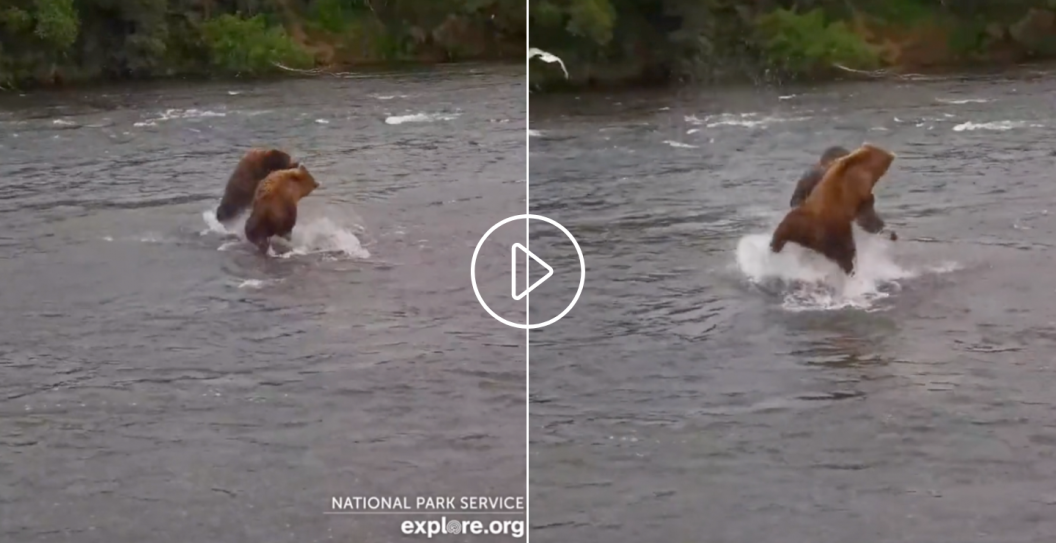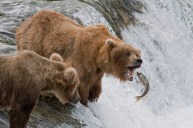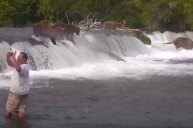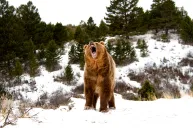Two big brown bears were caught on camera recently fighting for dominance over the same fishing spot at Brooks River Falls in Alaska's Katmai National Park.
The footage was caught by the National Park Service and Explore.Org, an organization that operates remote live cameras all over the world. The bears, identified as 856 and Walker, are two of the many beasts that have become low-key celebrities since the organizations live-cam feeds went up, allowing viewers to follow along as the bears fish for salmon throughout the summer and fall.
Tensions on the Brooks River can run high as the bears compete for early season prime feeding areas.
In the video, Bear 856 and Walker, both adult males, can be seen approaching each other in the water, reading body language, and then squaring up for a fight. The camera weaves in and out of focus as Bear 856 and Walker swat and snarl. Each takes turns standing on its back legs and hitting the other before they seemingly become disinterested in the fight.
After trading a few blows, the bears stand facing each other before eventually back away. There are no noticeable injuries and certainly nothing that might be fatal. It is unclear which bear was crowned the winner.
856 vs. Walker: Brooks Falls heated up last night as two dominant forces went head to head. No serious injuries reported. pic.twitter.com/5c2OOsUOcw
— explore.org (@exploreorg) July 2, 2023
The Celebrity Bears
Explore.org has been following these two bears, among others, for years. Walker has matured into a formidable dominator.
"Walker remained a tolerant and playful bear during his young adult years," Explore.org's website states. "He allowed other bears to approach him, and he sought sparring partners for prolonged play fights. However, his priorities have changed as he matured into a fully grown adult...With his large body size and assertive disposition, Walker is one the river's most dominant bears."
Explore started following Bear 856 was classified in 2006. As an adult, he became one of the biggest bears at the river with an assertive disposition equal to his size.
"Although he experienced some setbacks along the way, 856 was the river's most consistently dominant bear between 2011 and 2020," it read." He uses his size and fighting skills to intimidate other bears in order to gain access to food and potential mates... As he ages, 856 experiences increasingly tough competition from younger bears. Yet despite the danger, difficulty, and risk that he experiences, 856's reign demonstrates that some bears thrive through a life full of conflict."
According to the National Park Service, Brooks Falls is one of the best places in the world to watch brown bears because it is one of the first streams in the region where energetic and pre-spawned salmon are available to bears. In July, most salmon are moving through large rivers and lakes where bears cannot successfully fish. Early in the salmon run, Brooks Falls creates a temporary barrier to migrating salmon. This results in a particularly successful fishing spot for bears. Once salmon stop migrating in large numbers, Brooks Falls is no longer a good place to fish and bears quickly abandon that spot for better fishing elsewhere.
Both Walker and Bear 856 are brown bears. According to the Alaska Department of Fish and Game, brown bears are a type of grizzly bear that live in southern Alaska that grow especially large, reaching sizes of up to 1,500 pounds. While these bears are generally solitary in nature, brown bears clusters often occur in concentrated feeding areas such as salmon spawning streams, sedge flats, open garbage dumps or on whale carcasses.
Why Bears Fight
Bears don't fight often, but it is common behavior for them to fight for fishing locations. In many places, there are more bears seeking fish to eat than the available fish that are there, thus, the bears fight over a limited resource.
Usually before escalating to physical conflicts, bears use a series of vocalizations and body posturing to express temperament and dominance, according to the NPS. Less dominant bears (typically smaller subadult bears and females) yield space, such as fishing spots, and resources, like a dead salmon, to more dominant bears (larger bears and adult males).
Through the establishment of a fluid hierarchy, bears have evolved a social adaptation that allows them to avoid fighting in most instances.
READ MORE: Watch: Whitetail Doe Stomps a Coyote Attacking Her Fawn




